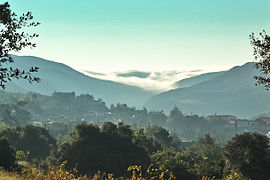Sournia (French pronunciation: [suʁnja] ; Catalan: Sornià; Occitan: Sornhan) is a commune in the Pyrénées-Orientales department in the Occitanie region of south-western France. Its inhabitants are known as Sourniannais.
Sournia
Sornià Sornhan | |
|---|---|
 A general view of Sournia | |
| Coordinates: 42°43′43″N 2°26′34″E / 42.7286°N 2.4428°E | |
| Country | France |
| Region | Occitania |
| Department | Pyrénées-Orientales |
| Arrondissement | Prades |
| Canton | La Vallée de l'Agly |
| Government | |
| • Mayor (2020–2026) | Yvon Crambes[1] |
Area 1 | 29.99 km2 (11.58 sq mi) |
| Population (2021)[2] | 486 |
| • Density | 16/km2 (42/sq mi) |
| Time zone | UTC+01:00 (CET) |
| • Summer (DST) | UTC+02:00 (CEST) |
| INSEE/Postal code | 66198 /66730 |
| Elevation | 380–1,234 m (1,247–4,049 ft) (avg. 500 m or 1,600 ft) |
| 1 French Land Register data, which excludes lakes, ponds, glaciers > 1 km2 (0.386 sq mi or 247 acres) and river estuaries. | |
Geography
editSournia is a town of the Fenouillèdes, the languedocienne part of the Pyrénées-Orientales, in the canton of La Vallée de l'Agly and in the arrondissement of Prades. The river Désix runs through the village. Sournia is 22 km from Ille-sur-Têt and from Vinça, 24 km from Prades and from Saint-Paul-de-Fenouillet, 30 km from Latour-de-France and 34 km from Axat.
The commune is covered by the quality wine standard AOC 'Côtes-du-Roussillon'.
Sournia is crossed by the long-distance footpath, GR 36.
Administration
editThe current mayor of Sournia is Paul Blanc, a senator, of the centre-right and right wing party UMP founded by Jacques Chirac.
Population
editThe population of Sournia in 2017 was 498 people. For some reason at the end of the 19th century, the population of Sournia seemed to have a reputation for having one of the longest longevity in France, even though this fact was not clearly verified.[3]
|
| ||||||||||||||||||||||||||||||||||||||||||||||||||||||||||||||||||||||||||||||||||||||||||||||||||||||||||||||||||
| |||||||||||||||||||||||||||||||||||||||||||||||||||||||||||||||||||||||||||||||||||||||||||||||||||||||||||||||||||
| Source: EHESS[4] and INSEE (1968–2017)[5] | |||||||||||||||||||||||||||||||||||||||||||||||||||||||||||||||||||||||||||||||||||||||||||||||||||||||||||||||||||
Places of interest
edit- Ruins of the former church of Saint-Michel from the tenth century.[6]
- The ancient church of Sainte-Félicité from the tenth and eleventh centuries.[6]
- Church of Arsa from the twelfth century.
-
Saint-Michel
-
Sainte-Félicité
-
Saint-Laurent d'Arsa
-
The apse, Saint-Laurent d'Arsa
See also
editReferences
edit- ^ "Répertoire national des élus: les maires" (in French). data.gouv.fr, Plateforme ouverte des données publiques françaises. 13 September 2022.
- ^ "Populations légales 2021" (in French). The National Institute of Statistics and Economic Studies. 28 December 2023.
- ^ (in French) Fabricio Cardenas, Vieux papiers des Pyrénées-Orientales, Record de longévité à Sournia en 1897 , 3 January 2015
- ^ Des villages de Cassini aux communes d'aujourd'hui: Commune data sheet Sournia, EHESS (in French).
- ^ Population en historique depuis 1968, INSEE
- ^ a b Rush, Simon John Nowell (2022), The first Romanesque architecture of Conflent, Pyrénées-Orientales, France (66). Tradition, system and style. [Thesis] Volume 1 (text), especially pages 126-7; and Volume 2 (illustrations), especially Figures 70-87.



